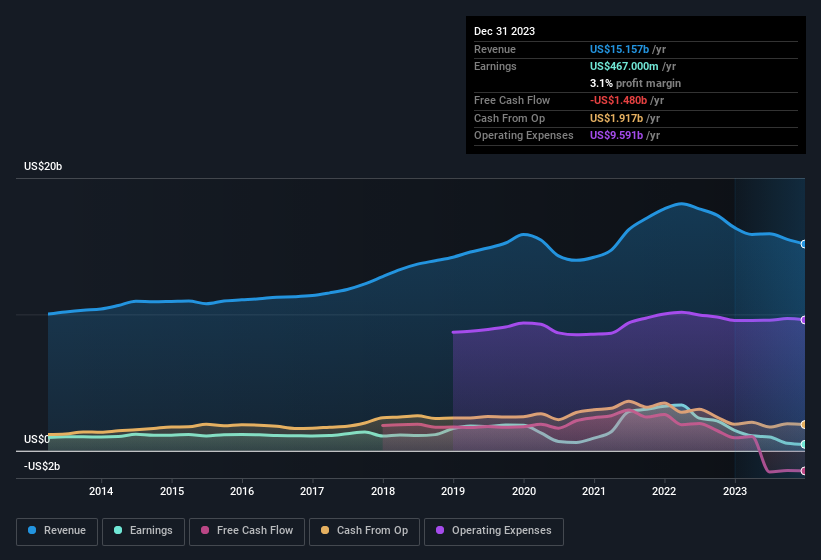- United States
- /
- Personal Products
- /
- NYSE:EL
Estée Lauder Companies' (NYSE:EL) Sluggish Earnings Might Be Just The Beginning Of Its Problems

The Estée Lauder Companies Inc.'s (NYSE:EL) stock showed strength, with investors undeterred by its weak earnings report. Sometimes, shareholders are willing to ignore soft numbers with the hope that they will improve, but our analysis suggests this is unlikely for Estée Lauder Companies.
See our latest analysis for Estée Lauder Companies

Examining Cashflow Against Estée Lauder Companies' Earnings
Many investors haven't heard of the accrual ratio from cashflow, but it is actually a useful measure of how well a company's profit is backed up by free cash flow (FCF) during a given period. To get the accrual ratio we first subtract FCF from profit for a period, and then divide that number by the average operating assets for the period. You could think of the accrual ratio from cashflow as the 'non-FCF profit ratio'.
As a result, a negative accrual ratio is a positive for the company, and a positive accrual ratio is a negative. While it's not a problem to have a positive accrual ratio, indicating a certain level of non-cash profits, a high accrual ratio is arguably a bad thing, because it indicates paper profits are not matched by cash flow. Notably, there is some academic evidence that suggests that a high accrual ratio is a bad sign for near-term profits, generally speaking.
Over the twelve months to December 2023, Estée Lauder Companies recorded an accrual ratio of 0.20. We can therefore deduce that its free cash flow fell well short of covering its statutory profit. In the last twelve months it actually had negative free cash flow, with an outflow of US$1.5b despite its profit of US$467.0m, mentioned above. We saw that FCF was US$945m a year ago though, so Estée Lauder Companies has at least been able to generate positive FCF in the past.
That might leave you wondering what analysts are forecasting in terms of future profitability. Luckily, you can click here to see an interactive graph depicting future profitability, based on their estimates.
Our Take On Estée Lauder Companies' Profit Performance
Estée Lauder Companies didn't convert much of its profit to free cash flow in the last year, which some investors may consider rather suboptimal. Therefore, it seems possible to us that Estée Lauder Companies' true underlying earnings power is actually less than its statutory profit. Sadly, its EPS was down over the last twelve months. Of course, we've only just scratched the surface when it comes to analysing its earnings; one could also consider margins, forecast growth, and return on investment, among other factors. If you'd like to know more about Estée Lauder Companies as a business, it's important to be aware of any risks it's facing. For instance, we've identified 4 warning signs for Estée Lauder Companies (2 don't sit too well with us) you should be familiar with.
Today we've zoomed in on a single data point to better understand the nature of Estée Lauder Companies' profit. But there is always more to discover if you are capable of focussing your mind on minutiae. Some people consider a high return on equity to be a good sign of a quality business. While it might take a little research on your behalf, you may find this free collection of companies boasting high return on equity, or this list of stocks that insiders are buying to be useful.
Valuation is complex, but we're here to simplify it.
Discover if Estée Lauder Companies might be undervalued or overvalued with our detailed analysis, featuring fair value estimates, potential risks, dividends, insider trades, and its financial condition.
Access Free AnalysisHave feedback on this article? Concerned about the content? Get in touch with us directly. Alternatively, email editorial-team (at) simplywallst.com.
This article by Simply Wall St is general in nature. We provide commentary based on historical data and analyst forecasts only using an unbiased methodology and our articles are not intended to be financial advice. It does not constitute a recommendation to buy or sell any stock, and does not take account of your objectives, or your financial situation. We aim to bring you long-term focused analysis driven by fundamental data. Note that our analysis may not factor in the latest price-sensitive company announcements or qualitative material. Simply Wall St has no position in any stocks mentioned.
About NYSE:EL
Estée Lauder Companies
Manufactures, markets, and sells skin care, makeup, fragrance, and hair care products worldwide.
Moderate growth potential with mediocre balance sheet.
Similar Companies
Market Insights
Community Narratives


